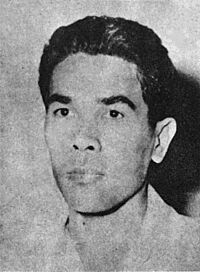Herman Johannes facts for kids
Quick facts for kids
Herman Johannes
|
|
|---|---|
 |
|
| 7th Minister of Public Works of the Republic of Indonesia | |
| In office 6 September 1950 – 27 April 1951 |
|
| President | Sukarno |
| Preceded by | Mananti Sitompul |
| Succeeded by | Ukar Bratakusumah |
| 2nd Rector of Gadjah Mada University | |
| In office 1961–1966 |
|
| Preceded by | M. Sardjito |
| Succeeded by | M. Nazir Alwi |
| Personal details | |
| Born | 28 May 1912 Rote, Dutch East Indies |
| Died | 17 October 1992 (aged 80) Yogyakarta, Indonesia |
Herman Johannes (born May 28, 1912 – died October 17, 1992) was an important Indonesian professor, scientist, and politician. He is also known as a National Hero. Johannes served as the leader (Rector) of Universitas Gadjah Mada in Yogyakarta from 1961 to 1966. He also helped manage higher education in Indonesia and was a member of the President's top advisory group. From 1950 to 1951, he was the Minister for Public Works and Energy. He was also part of the Executive Board of UNESCO from 1954 to 1957.
Contents
Life Story of Herman Johannes
Herman Johannes finished his studies at Technische Hogeschool (THS) in Bandung, West Java. This school later moved to Yogyakarta in 1946. This move happened during the war for independence against the Dutch. The school eventually became the beginning of Gadjah Mada University.
Research and Inventions
During his time as a professor, Johannes worked on making technology better for people in villages. He invented a special charcoal stove for people who didn't have much money. This stove used fuel made from biomass charcoal briquettes. Johannes also looked into other kinds of fuels. He explored how to turn waste from farms into fuel.
Role in the War for Independence
Herman Johannes was involved in the military in the 1940s. He led the Indonesian Army Arsenal Laboratory during the independence war. His lab made explosives like smoke bombs and hand grenades. Indonesian fighters used these to stop the Dutch military in Central Java.
Family Life
Herman Johannes married Annie Marie Gilbertine Amalo in 1955. They had four children: Christine, Henriette, Daniel Johannes, and Helmi Johannes. Helmi later became a newscaster for the VOA.
Awards and Passing
The Indonesian government gave Johannes the Guerilla Medal in 1958. He also received the Mahaputra Medal in 1973. Herman Johannes passed away on October 17, 1992, from prostate cancer. He was buried at the Universitas Gadjah Mada Cemetery in Yogyakarta. In November 2009, the Indonesian government honored him as a National Hero.
How Herman Johannes is Remembered
The Indonesian government honored Herman Johannes in several ways. They named a large forest park in Kupang Regency, East Nusa Tenggara province, after him. A main street in downtown Yogyakarta also carries his name.
His face is also shown on the 100 Indonesian rupiah coins that were made in 2016.
Education Journey
- Melayu School, Baa, Rote Island, East Nusa Tenggara, Indonesia (1921)
- Europesche Lagere School (ELS), Kupang, East Nusa Tenggara, Indonesia (1922)
- Meer Uitgebreid Lager Onderwijs (MULO), Makassar, South Sulawesi, Indonesia (1928)
- Algemene Middelbare School (AMS), Batavia, Java, Indonesia (1931)
- Technische Hogeschool (THS), Bandung, West Java, Indonesia (1934)
Career Highlights
- Teacher, Cursus tot Opleiding van Middelbare Bouwkundingen (COMB), Bandung (1940)
- Teacher, High Middle School (SMT), Batavia, Java (1942)
- Lecturer of Physics, Medical High School, Salemba, Jakarta (1943)
- Lecturer, Technical High School (STT) Bandung in Yogyakarta (1946–1948)
- Professor, STT Bandung in Yogyakarta (June 1948)
- Dean, Technical Faculty, Universitas Gadjah Mada (UGM), Yogyakarta (1951–1956)
- Dean, Faculty of Natural Sciences (FIPA), Gadjah Mada University, Yogyakarta (1955–1962)
- Rector (Leader), Universitas Gadjah Mada, Yogyakarta (1961–1966)
- Coordinator of Higher Education (Koperti), Yogyakarta and Central Java (1966–1979)
- Chairman, Regional Science and Development Center (RSDC), Yogyakarta (1969)
Other Important Roles
- Member, Central Indonesian National Committee (KNIP) (1945–1946)
- Minister of Public Works and Energy, Indonesia (1950–1951)
- Member, Executive Board of UNESCO (1954–1957)
- Member, National Council (1957–1958)
- Member, National Development Council (Deppernas) (1958–1962)
- Member, Supreme Advisory Council (Dewan Pertimbangan Agung or DPA) Indonesia (1968–1978)
- Member Commission of Four (1970)
- Member, Committee for Technical Terms, Department of Public Works (1969–1975)
- Member, Council of Indonesian-Malaysian Language (MABIM) (1972–1977)
- Member, Indonesian National Research Council (1985–1992)
Military Service
- Head of Arsenal Laboratory, Army Headquarters, Yogyakarta (1946)
- Member of Military Academy Troops, Jogjakarta, Sector Sub-Wehrkreise 104 (December 1948 – June 1949)
- Lecturer, Military Academy, Yogyakarta (1946–1948)
- Last Rank: Army Major (1949)
- Commandant, Yogyakarta Student Regiment (Resimen Mahakarta) (1962–1965)
Organizations He Joined
- Christen Studenten Vereniging (CSV), Bandung (1934)
- Indonesische Studenten Vereniging (ISV), Bandung (1934)
- Timorese Jongeren/Chairman of Timorese Nationalist Group (PKT), Bandung (1934)
- Member, Indonesian Young Civil Servants Association (AMPRI), Jakarta (1945)
- Chairman, Indonesian Lesser Sunda People's Movement (GRISK) (1947)
- Founder, Greater Indonesia Party (PIR) (1948)
- Chairman, Hatta Foundation (1950–1992)
- Chairman of Gadjah Mada University Alumni Association (KAGAMA) (1958–1961, 1973–1981)
- Head of Yogyakarta's Veterans Legion
- Part of the Central Board of the Indonesian Veterans Legion (LVRI)
- Member of Indonesian Engineers Association (PII)
- Honorary Member of the Indonesian Academy of Sciences (AIPI)
Awards and Honors
- Guerilla Medal (1958)
- Medal of Indonesian Independence Struggle (1961)
- Medal of Wirakarya (1971)
- Mahaputra Medal (1973)
- Doctor Honoris Causa, Gadjah Mada University (1975)
- Veterans Legion Medal (1981)
- Honor of Sri Sultan Hamengkubuwono IX (1991)
- Indonesian National Hero (2009)

